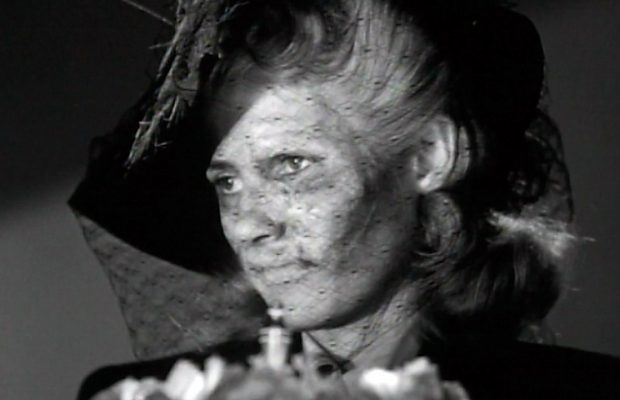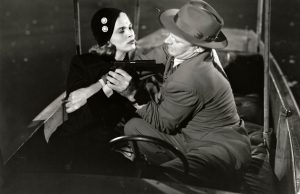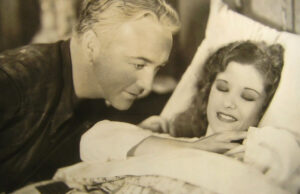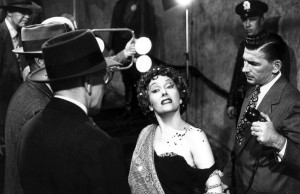Strange Impersonation (1946)

Toronto Film Society presented Strange Impersonation (1946) on Monday, August 28, 2017 in a double bill with A Woman’s Vengeance as part of the Season 70 Summer Series, Programme 7.
Distribution: Republic Pictures Corp. Producer: William Wilder. Director: Anthony Mann. Screenplay: Mindret Lord, based on a story by Anne Wigton and Lewis Herman. Cinematography: Robert W. Pittack. Art Director: Edward C. Jewell (uncredited). Set Decorations: Sydney Moore. Music Director: Alexander Laszlo. Sound: Earl Crain, Sr. Makeup Supervisor: Bud Westmore. Release Date: March 16, 1946.
Cast: Brenda Marshall (Nora Goodrich), William Gargan (Dr. Stephan Lindstrom), Hillary Brooke (Arline Cole), George Chandler (Jeremiah Wilkin Rinse), Ruth Ford (Jane Karanski), H.B. Warner (Dr. Mansfield), Lyle Talbot (Inspector Malloy), Mary Treen (Nurse), Cay Forester (Miss Roper), Richard Scott (Detective).

Strange Impersonation, was Anthony Mann’s final film for Republic Pictures. Irrespective of his reservations on making the film, the picture is an ingenious and frenzied little thriller, an appropriate culmination of the director’s association with the bizarre independent studio of Herbert J. Yates.
Putting aside its conventional musings about a woman choosing between career and marriage, Strange Impersonation unveils the most spellbinding female character to be found in an Anthony Mann picture, Dr. Nora Goodrich. In this role, Mann directed yet another underutilized actress, the stunning brunette Brenda Marshall, wife of actor William Holden, and a former Warner Bros. contract player whose few distinctive credits were The Sea Hawk (1940) and The Constant Nymph (1943). Strange Impersonation did not lead the thirty-year-old Marshall to stronger roles and this would be her third to last film.
In the scene where Marshall drives home actress Ruth Ford, she is harassed by an ambulance-chasing attorney. Censor Joseph I. Breen of the Production Code Administration lost a battle with Republic to change this unsavory character into “possibly a process server, taxicab man, or some busybody” in order to avoid “widespread offense to the legal profession.”
There is an in-joke in the film to screenwriter Mindret Lord from the outset as we learn that Nora’s place of employment is the Wimott Institute, founded in 1903 by “Mindret L. Wimott.” Mindret Lord, who wrote the screenplay, was a writer with a macabre pulp fiction imagination, and it was rumoured that he was related to murderer Richard Loeb of the notorious Leopold-Loeb case that inspired Alfred Hitchock’s Rope (1948) and Richard Fleischer’s Compulsion (1959). Regrettably, Lord’s life was as troubled as his storylines and he committed suicide in late 1955 not long after the release of his first produced big-budget studio screenplay, The Virgin Queen, starring Bette Davis as Elizabeth.
Apparently, Mann never mentioned tonight’s movie in interviews, so it is possible that Strange Impersonation wasn’t as satisfying to him as some of his other films, although this doesn’t make the film any less entertaining for us.
Sourced from The Crime Films of Anthony Mann by Max Alvarez (2014)
Introduction by Caren Feldman

Although he would not hit his stride until Desperate (1947), Strange Impersonation, and the earlier The Great Flammarion (1945), demonstrates Anthony Mann’s progression towards being one of the most significant—certainly the most representative—director of noir films; a strong claim for a director who is known as much for his westerns, perhaps even his epic films, as he is for his films-noirs. But the evidence is there: besides directing more traditional, “hardboiled” entries, like Railroaded and Raw Deal, Mann introduced the semi-documentary into the cycle (T-Men); made period pieces (The Black Book) and even historical dramas (The Tall Target) in the noir style; and created the blackest of all westerns, Devil’s Doorway—all within a span of about six years. Directors as renowned as Nicholas Ray have credited Mann with a special gift for heightening cinematic violence without displaying much gore. And his collaborations with photographer John Alton, both at Eagle-Lion and M.G.M., represent the epitome of the cycle’s expressionistic use of light and shadow.
One of his lesser efforts, Strange Impersonation, was hampered by budgetary and temporal constraints and a plot whose deficiencies strained credulity beyond the breaking point. Yet it remains an important cog in Mann’s progression and contains a number of defining motifs of the film-noir. Although shot in a rather pedestrian manner, the sequence near the end, where Nora is interrogated by the police, stands out: Nora is illuminated harshly by an overhead lamp (typical of such interrogation scenes), but camera position alternated obliquely from high angle to low angle in such a way that Nora’s sense of oppression and entrapment is enhanced, culminating finally in a montage of accusing faces in extreme close-up. The doppelganger theme is given visual correlative through an abundance of mirror images (a penchant for which Mann would later refine in T-Men and Raw Deal). Even those sudden, precipitous plot twists leading to a rather weak, pre-emptive conclusion—“it’s all a dream”—is not alien to the film-noir (cf. Fritz Lang’s The Woman in the Window).
The Film Noir Encyclopedia by Robert Porfiro, Overlook Press, New York (2010)
Notes compiled by Peter Poles










Leave a Reply